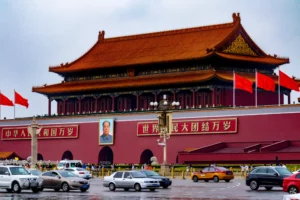
Is the China-Europe Relations at a Crossroads in 2024?
Navigating the crossroads of China-Europe relations: Discover the balance of cooperation, competition, and the path ahead in 2024.

Asia, with its vast expanses and rich tapestry of cultures, stands as a beacon of diversity and complexity. The construction of its territories, shaped by millennia of history, geography, and human endeavor, presents a fascinating study in contrast and continuity. This article, “Understanding The Dynamics of Asian Territories Construction,” delves into the multifaceted aspects of how Asian territories have been constructed over the ages, influenced by historical legacies, geographical diversities, and the modern-day geopolitical landscape.
Asia’s geography is as diverse as its cultures. Stretching from the frozen tundra of Siberia to the tropical rainforests of Southeast Asia, this continent showcases an incredible variety of landscapes. Its territories, home to over 4.5 billion people, are a mosaic of myriad cultures, languages, and histories. Asia’s diversity is not just cultural but also geographical, impacting the construction and development of its territories significantly.
Asia is divided into various subregions, each with its own unique characteristics and challenges. These include:
Central Asia, known for its vast steppes and pivotal position in the Silk Road.
Southern Asia, home to the Indian subcontinent with its rich history and cultural diversity.
Eastern Asia, dominated by China’s vast landscapes and significant historical influence.
Southeastern Asia, characterized by its tropical climates, archipelagos, and dynamic economies.
Northern Asia, largely encompassing the Siberian wilderness.
This geographical diversity has influenced the construction of territories, shaping settlements, urban planning, and economic development across the continent.
The history of Asia is a tapestry of empires, conquests, and civilizations that have left indelible marks on its territories. From the Mongol Empire’s vast expanse to the intricate city planning of the Indus Valley Civilization, historical influences permeate the construction of modern Asian territories.
The architectural legacies of ancient and medieval empires provide insight into their influence on territory construction. For instance, the Great Wall of China and the Angkor Wat temple complex in Cambodia are not just tourist attractions but symbols of how historical powers shaped their territories for defense, religion, and society.
For Further Reading: Britannica – Asia
European colonization significantly altered Asian territories’ construction. The colonial powers introduced new architectural styles, urban planning concepts, and administrative divisions, many of which have persisted into the modern era. This blend of indigenous and colonial influences is evident in cities like Mumbai, India, and Penang, Malaysia, where colonial-era buildings stand alongside traditional structures.
Asia’s construction dynamics cannot be understood without considering its geographical and cultural complexity. This complexity affects everything from infrastructure development to urban planning.
In regions like Southeast Asia, where waterways are crucial for transportation and livelihoods, communities have constructed their homes, cities, and transportation networks to adapt to the aquatic environment. Similarly, in earthquake-prone areas like Japan, construction techniques have evolved to make buildings more resilient to seismic activity.
For Further Reading: Asian Spaces in Globalization
This exploration of Asia’s territories, from their historical roots to their contemporary construction, reveals a continent where the past and present merge, shaping the future of its diverse landscapes and cultures. The next sections will delve deeper into the impact of colonial legacies, current geopolitical tensions, and the role of ethnic and cultural diversity in the construction of Asian territories.
The shadows of colonialism stretch long across the Asian continent, impacting the construction and development of its territories well into the modern era. The colonial period introduced new administrative frameworks, economic structures, and urban planning methodologies that have had lasting effects on Asian territories.
Colonial powers often redesigned cities to reflect their vision of order, efficiency, and control. This is evident in the wide, straight streets of Kolkata, India, and the French Indochinese architecture of Hanoi, Vietnam. These urban designs were meant to facilitate administrative control and economic extraction, but they also introduced modern infrastructure and planning concepts to Asia.
The colonial legacy in Asian territories construction is not limited to architecture and urban planning. It also includes the establishment of plantations, mines, and trading ports, which have shaped the economic geography of regions like Indonesia and Malaysia. These activities have led to enduring social and economic structures that continue to influence the development of these territories.
For Further Reading: SmartHistory – History of Asia
In recent years, geopolitical tensions have significantly influenced the construction of territories in Asia. From the South China Sea to the borders of India and Pakistan, territorial disputes have prompted nations to engage in infrastructure and military construction projects that assert their sovereignty and strategic interests.
China’s Belt and Road Initiative (BRI) exemplifies how infrastructure projects are used as geopolitical tools. By constructing roads, railways, and ports across Asia, China aims to enhance its influence and connectivity with other Asian territories. However, these projects also raise concerns among neighboring countries and global powers about strategic dominance and territorial integrity.
Military construction activities in contested territories like the South China Sea underscore the link between geopolitical tensions and territory construction. The building of military bases on reclaimed islands by various claimant countries not only alters the physical landscape but also the geopolitical map of the region.
For Further Reading: China’s Food Import Vulnerability
Asia’s ethnic and cultural diversity is a defining feature of its territories’ construction. The continent’s complex mosaic of languages, religions, and ethnic groups has influenced the development of national boundaries, regional autonomy, and community spaces.
Countries like China have established autonomous regions to accommodate the territorial claims of major ethnic groups. These regions, such as Xinjiang and Tibet, have unique administrative structures that reflect the central government’s attempts to balance national unity with ethnic diversity.
Cultural diversity in Asia has also led to the construction of unique urban spaces and landmarks. Cities such as Kuala Lumpur, with its iconic Petronas Towers, and Bangkok, with its historic temples, reflect the blend of ethnic identities and cultural heritages that characterize Asian territories.
This exploration of how colonial legacies, current geopolitical tensions, and the rich tapestry of ethnic and cultural diversity influence the construction of Asian territories provides a deeper understanding of the continent’s complex development landscape. The final section will discuss population dynamics, environmental considerations, and future trends in Asian territories construction.
The colonial era left a profound impact on the construction and development of Asian territories. European, Japanese, and American colonial powers imposed their architectural styles, land use policies, and economic systems on Asian lands, effects of which are visible to this day.
In many Asian cities, colonial architecture coexists with traditional designs, creating unique urban landscapes. For example:
The French Quarter in Hanoi, Vietnam, showcases French colonial architecture.
British colonial buildings in Kolkata, India, stand alongside ancient temples.
Colonial rule also restructured Asian economies and administrative systems, with lasting impacts on territorial construction and management. The introduction of cash crops, railroads, and new administrative centers reshaped economic geographies and urban centers across Asia.
Railway Networks: Initially built to transport goods for trade, now pivotal for daily commuting in countries like India and Malaysia.
Administrative Divisions: Many current national and state boundaries in Asia were drawn during the colonial period.
In contemporary Asia, geopolitical tensions often influence the construction and development of territories. Disputed borders, resource control, and strategic infrastructures like the Belt and Road Initiative shape the geopolitical landscape.
Countries use infrastructure projects not only for economic development but also as instruments of geopolitical strategy. For instance, China’s Belt and Road Initiative is seen as a means to exert influence across Asia through infrastructure development.
Disputes over territories in Asia, such as the South China Sea, have significant implications for construction and development. These disputes affect maritime boundaries, fishing rights, and the construction of military and civilian structures.
| Project Name | Country | Geopolitical Implications |
| Belt and Road Initiative | China | Expands China’s economic and strategic influence |
| Kra Canal | Thailand | Could alter regional shipping routes |
| China-Pakistan Economic Corridor | Pakistan | Strengthens China-Pakistan ties against India |
For Further Reading: China’s Food Import Vulnerability
Asia’s ethnic and cultural diversity plays a crucial role in the construction and development of its territories. Multiethnic countries like Indonesia and India face the challenge of developing territories that respect the cultural and economic needs of diverse populations.
In some cases, granting regional autonomy has been a strategy to address ethnic diversity in territory construction and management. This approach aims to ensure that development projects respect local cultures and economic practices.
Local Consultation: Engaging with local communities in the planning stages.
Cultural Preservation: Incorporating traditional architectural styles and urban planning principles.
Economic Inclusivity: Ensuring development projects provide economic benefits to all ethnic groups.
The construction of Asian territories is a dynamic process influenced by historical legacies, current geopolitical tensions, and the continent’s rich ethnic and cultural diversity. These factors together shape the unique landscape of Asia, highlighting the need for thoughtful and inclusive approaches to urban planning and development.
Asia’s demographic trends have a profound impact on the construction and development of territories. The continent is home to both rapidly growing and ageing populations, presenting unique challenges and opportunities for urban planners and policymakers.
Rapid urbanization in countries like India and China has spurred extensive urban development and infrastructure projects. Cities are expanding vertically and horizontally to accommodate the influx of residents moving from rural areas in search of better opportunities.
India’s Smart Cities Mission: Aims to create 100 smart cities with sustainable urban environments.
China’s Megacity Developments: Includes the integration of cities in the Pearl River Delta into a massive urban area.
The visualization above depicts the “Impact of Territorial Construction on Asian Urbanization Rate,” highlighting the significant increase in urbanization rates from 2000 to 2020 across five major Asian countries: China, India, Japan, South Korea, and Indonesia. This increase reflects the substantial influence of territorial construction projects, including urban development and infrastructure initiatives, on urbanization trends in Asia.
In contrast, countries like Japan face the challenge of an ageing population, leading to different priorities in territory construction, such as healthcare facilities and accessible urban designs.
Elderly-friendly Cities: Incorporating more walkable streets, public transportation options, and healthcare facilities.
Sustainability has become a key focus in the construction of Asian territories, driven by the need to address climate change, preserve natural resources, and ensure the well-being of future generations.
Innovative green building practices are being adopted across Asia, aiming to reduce environmental impact and promote sustainability.
Singapore’s Green Plan 2030: Aims to increase green spaces and develop eco-friendly buildings.
China’s Sponge Cities: Designed to absorb and reuse rainwater, reducing flood risks and improving urban water management.
Energy Efficiency: Utilizing renewable energy sources and energy-efficient building designs.
Sustainable Materials: Incorporating eco-friendly materials in construction projects.
Biodiversity Conservation: Designing projects that protect natural habitats and species.
The future of Asian territories construction lies in balancing rapid urbanization with sustainable development. Technological advancements, policy innovations, and international cooperation will play crucial roles in shaping this future.
The integration of digital technologies in urban planning and management is expected to enhance the efficiency, sustainability, and livability of Asian cities.
Digital Infrastructure: Implementing smart grids, intelligent transportation systems, and digital public services.
Regional collaboration and global partnerships are essential for addressing transboundary environmental challenges and promoting sustainable development across Asia.
ASEAN Smart Cities Network: A collaborative platform for ASEAN member states to work towards smart and sustainable urban development.
The construction and development of Asian territories are influenced by a complex interplay of historical legacies, geopolitical dynamics, demographic trends, and environmental considerations. As Asia continues to navigate the challenges and opportunities of the 21st century, its approach to territory construction will need to be adaptive, innovative, and inclusive, ensuring a sustainable and prosperous future for the continent.
For Further Reading: Regions – Asia
As Asia marches towards a future marked by rapid technological change and growing environmental concerns, its territories will undoubtedly reflect the resilience, creativity, and diversity that have long defined this region.

Navigating the crossroads of China-Europe relations: Discover the balance of cooperation, competition, and the path ahead in 2024.

The European Union must balance its interests with those of China as the rising power’s influence grows. Explore challenges and opportunities presented by China’s rise for Europe.

Asia’s rise and integration into globalization have been driven by various factors, including its active participation in global trade and investment, the role of the state in economic life, and a rapidly changing productive system.

China and Russia: Debunking the Myth of a Powerful Alliance

Unveiling China’s Food Security Challenges and Strategies: Import Dependency vs. Domestic Production.